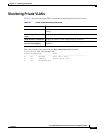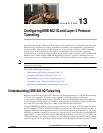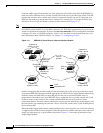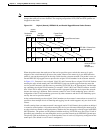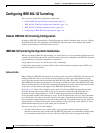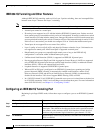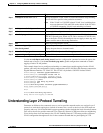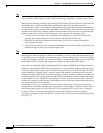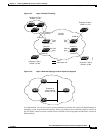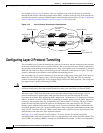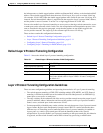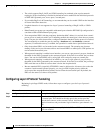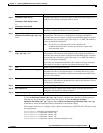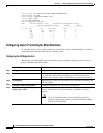
13-7
Cisco ME 3400 Ethernet Access Switch Software Configuration Guide
OL-9639-06
Chapter 13 Configuring IEEE 802.1Q and Layer 2 Protocol Tunneling
Understanding Layer 2 Protocol Tunneling
Use the no switchport mode dot1q-tunnel interface configuration command to return the port to the
default state of access. Use the no vlan dot1q tag native global configuration command to disable
tagging of native VLAN packets.
This example shows how to configure an interface as a tunnel port, enable tagging of native VLAN
packets, and verify the configuration. In this configuration, the VLAN ID for the customer connected to
Gigabit Ethernet interface 2 is VLAN 22. This VLAN is by default a UNI-ENI isolated VLAN.
Switch(config)# interface gigabitethernet0/2
Switch(config-if)# switchport access vlan 22
% Access VLAN does not exist. Creating vlan 22
Switch(config-if)# switchport mode dot1q-tunnel
Switch(config-if)# exit
Switch(config)# vlan dot1q tag native
Switch(config)# end
Switch# show dot1q-tunnel interface gigabitethernet0/2
dot1q-tunnel mode LAN Port(s)
-----------------------------
Gi0/1
Switch# show vlan dot1q tag native
dot1q native vlan tagging is enabled
Understanding Layer 2 Protocol Tunneling
Customers at different sites connected across a service-provider network need to use various Layer 2
protocols to scale their topologies to include all remote sites, as well as the local sites. STP must run
properly, and every VLAN should build a proper spanning tree that includes the local site and all remote
sites across the service-provider network. Cisco Discovery Protocol (CDP) must discover neighboring
Cisco devices from local and remote sites. VLAN Trunking Protocol (VTP) must provide consistent
VLAN configuration throughout all sites in the customer network that are participating in VTP.
Step 4
switchport access vlan vlan-id Specify the default VLAN, which is used if the interface stops trunking.
This VLAN ID is specific to the particular customer.
Note If the VLAN is a UNI-ENI isolated VLAN, local switching does
not occur between UNIs and ENIs on the switch. If the VLAN is
a UNI-ENI community VLAN, local switching is allowed.
Step 5
switchport mode dot1q-tunnel Set the interface as an IEEE 802.1Q tunnel port.
Step 6
exit Return to global configuration mode.
Step 7
vlan dot1q tag native (Optional) Set the switch to enable tagging of native VLAN packets on all
IEEE 802.1Q trunk ports. When not set, and a customer VLAN ID is the
same as the native VLAN, the trunk port does not apply a metro tag, and
packets could be sent to the wrong destination.
Step 8
end Return to privileged EXEC mode.
Step 9
show running-config
show dot1q-tunnel
Display the ports configured for IEEE 802.1Q tunneling.
Display the ports that are in tunnel mode.
Step 10
show vlan dot1q tag native Display IEEE 802.1Q native VLAN tagging status.
Step 11
copy running-config startup-config (Optional) Save your entries in the configuration file.
Command Purpose



